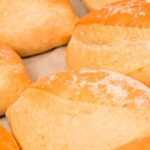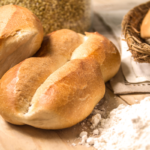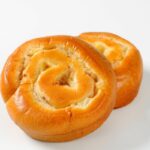There is nothing better than making homemade bread. There are so many types of bread that you can make at home and one of the most delicious and impressive is ciabatta bread.
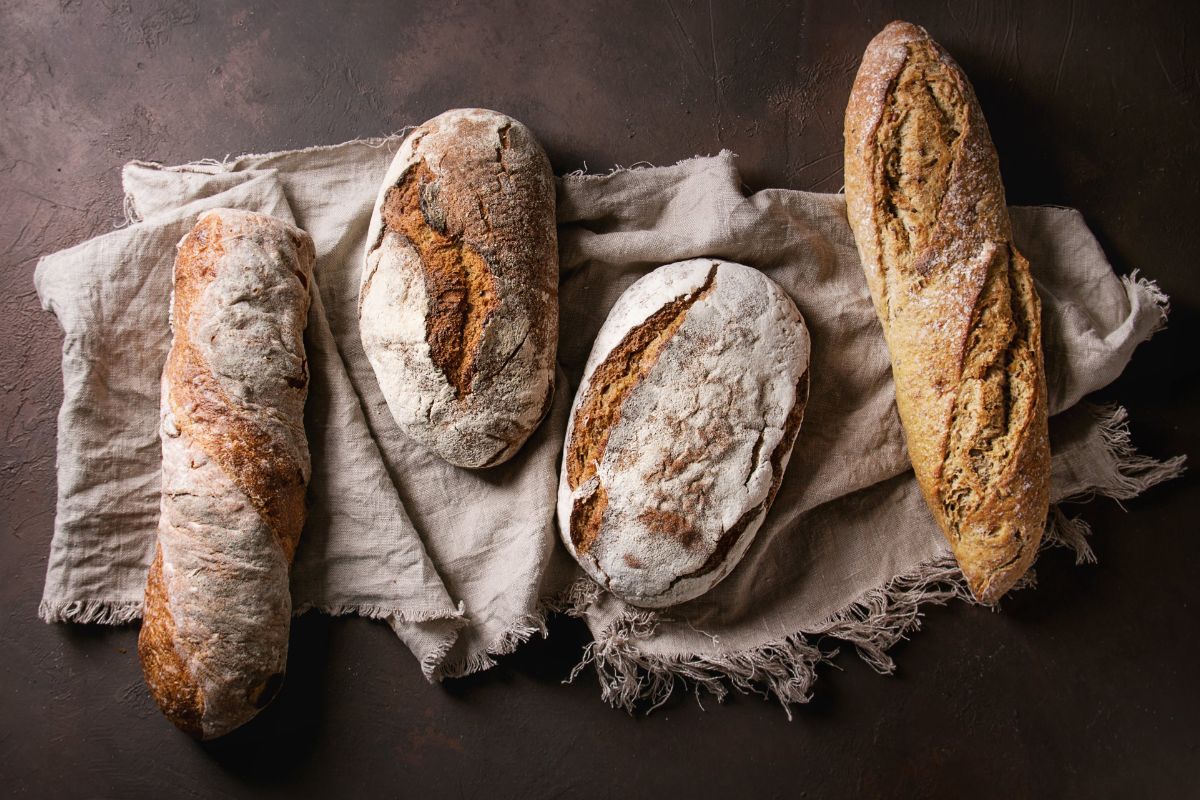
This Italian bread has a rustic look with a crunchy crust but a porous texture that allows it to soak up soups and sauces.
Getting your ciabatta dough right is easier than you may think! You don’t need any special equipment or ingredients but you can’t just knead the dough as you would with other types of bread.
To get ciabatta’s perfectly chewy texture, there is another technique that you need to use.
In this article, we will introduce an easy artisan ciabatta recipe. We’ll explain all you need to know to make delicious ciabatta bread at home.
Artisan Ciabatta Bread Recipe
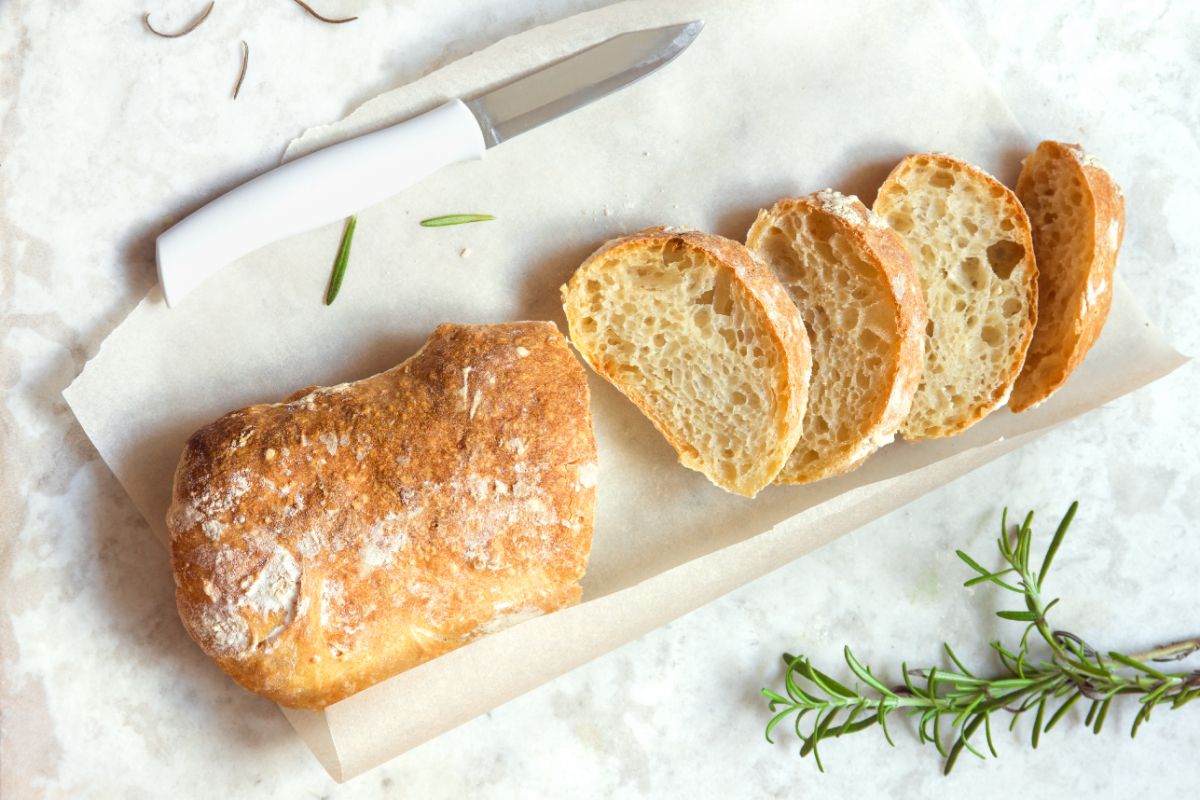
Let’s now get into our recipe for our artisan ciabatta bread. We will break down the equipment and ingredients you need before taking you through the instructions.
Equipment
- Bowl
- Wooden spoon
- Stand mixer and dough hook attachment (optional)
- Plastic wrap
- Parchment paper
- Baking stone/baking tray
Ingredients
- 2 and ½ cups (350 grams) of flour
- 1 and ¼ cups (280 grams) of water
- 1 teaspoon of yeast
- 1 teaspoon of salt
Instructions
Now let’s explain how to make this easy artisan ciabatta bread. There are many different techniques you can use to make ciabatta bread and the one we’ve chosen for this recipe will bake bread that is wonderfully soft and chewy.
Before you start, remember to preheat your oven to 450 degrees Fahrenheit (230 degrees Celsius.) You will need to turn down the oven later in the baking process but it will start at this high temperature. You should also preheat your baking stone or baking tray first.
Step One
Pour your water into your bowl and add your yeast and salt. Make sure that the yeast and salt are fully dissolved in the water before you continue.
Step Two
Add your flour to the water mixture. Use the end of your wooden spoon to stir the flour into the water. We recommend mixing your flour in this manner because it is calmer and will prevent mess.
Step Three
If you have a stand mixer and dough hook attachment, you can use this to mix the ingredients and form the dough.
This isn’t necessary, however, as you can mix everything together by hand just as easily. Once you have mixed the dough, cover your bowl with some plastic wrap and let it stand in a warm environment for 30 minutes.
Step Four
The dough needs to be proofed before it can be baked. In the case of most bread doughs, this is usually done by kneading the dough. However, this artisan ciabatta bread dough has a high level of water in it so kneading the dough will be more difficult.
Instead, we have to use a different method that does the same job but works better than kneading for artisan ciabatta bread.
This is a slow method of stretching and folding the dough. To fully prepare the dough will take two hours with a round of stretching and folding after every 30 minutes.
You will find the stretching and folding to be easier if you wet your fingers with some water first.
Step Five
After your ciabatta bread has been resting for 30 minutes, remove the plastic wrap that covers the bowl.
Lift and pull one side of the ciabatta dough and then fold this back onto itself. Turn your bowl 90 degrees and repeat the pull and fold motion. Repeat this action of turning your bowl and pulling and folding the dough until you have done it four times, once on each side.
Step Six
Once you have finished pulling and folding the dough, pick up the dough and turn it over. Recover the bowl with your plastic wrap and let it sit in a warm environment for another 30 minutes.
When the 30 minutes have passed, repeat step five and step six.
In total, you should pull and fold the ciabatta dough three times. This process will take about two hours and when it is fully finished, your ciabatta dough should be around twice the size it started as.
Step Seven
Sprinkle some flour on your countertop and place your ciabatta dough on the work surface,
Pull your dough so that it forms a rectangular shape. It’s best to do this by pulling the dough from underneath instead of at the top.
Once you have a rectangular shape, begin to roll the dough so that it forms a log. Pinch the edge of your dough log to seal it and make it neat.
Step Eight
Divide your rolled dough into three even parts.
Separate the parts and spread them out on your floured work surface. Make sure there is plenty of space between each of the three parts as your dough will rise and expand even further. You want to make sure that the parts don’t touch each other and become joined.
Sprinkle the dough with some flour and then cover it all with some plastic wrap.
Step Nine
Make sure your dough is properly covered and leave it for 45 minutes for a second rise and proofing.
Step Ten
After 46 minutes have elapsed, unwrap your ciabatta dough. Gently stretch the dough once more to shape the dough. You can form it into long rectangles.
Step Eleven
Once shaped, place your dough onto a parchment paper-lined preheated baking sheet or baking stone. Spray your dough with a little water and place it in your preheated oven.
Step Twelve
You should bake the ciabatta bread dough at 450 degrees Fahrenheit (230 degrees Celsius) for 10 minutes. After the 10 minutes have passed, turn down the oven temperature to 400 degrees Fahrenheit (205 degrees Celsius.) Bake the dough for another 12 to 15 minutes,
Step Thirteen
Be careful to not take your bread out of the oven too early. It may appear to be fully baked when it hits 20 minutes in total, but give the bread another five minutes to ensure it gets crusty and full of flavor.
Frequently Asked Questions
Now that we’ve introduced our recipe for artisan ciabatta bread, let’s answer some commonly asked questions about it.
Most other types of bread include some sort of fat in their recipe. This is often just a little oil but it affects the bread. The doughs are usually quite dry as well, making them easy to knead.
However, ciabatta bread doesn’t have any fat. It also has a higher ratio of water to dry ingredients and this makes a wetter dough.
The combination of no oil and wetter dough produces a dough that is chewy and has a crispy crust. This is ideal for artisan ciabatta bread.
Many artisan Italian and French bread recipes call for pre-ferments to be included in the ingredients. These can be starters, biga, poolish, or sponge but they all serve the same purpose and their only real difference is how much water they include.
Bread like ciabatta takes more time to prepare than some other types of bread so preferments are used. Any loaves of bread that are made with these preferments tend to remain fresh for longer as well.
By skipping any preferments, the recipe instantly becomes easier. In our opinion, preferments don’t make much difference to the taste and flavor of this bread so we can safely skip this ingredient.
Both ciabatta and focaccia are popular Italian breads. They’re two of the most well-known Italian breads and you may be wondering what the difference between them is.
The main difference between them is that focaccia is a flatbread and is often made without any yeast. It’s rolled out flat and isn’t expected to rise. On the other hand, ciabatta does include yeast and is prepared so that it will rise. It’s formed into and served as loaves.
As we mentioned earlier, ciabatta usually does not include any type of oil at all. However, focaccia usually does have some oil in its dough and this gives it a softer texture than the texture of ciabatta bread.
Ciabatta dough is a very wet dough. It has high levels of hydration compared to other types of bread.
The average type of bread dough has hydration levels of 60 percent, but the hydration level of the ciabatta bread dough in this recipe is nearer 80 percent. As you can see, this makes a very wet dough!
The high levels of hydration make kneading ciabatta dough very difficult. It doesn’t stand up well to being kneaded and it is best prepared in the pull and fold method that we detailed during the instructions instead.
This method of pulling and folding will also encourage the bread to ferment during the slow process.
The pull-and-fold method does more than just shape your dough and allow it to rise, however. There are two other main benefits of preparing your ciabatta dough in this way.
The first is that pulling and folding the dough allows the gluten in the dough to layer. This gives the bread more structure and gives ciabatta bread the lovely texture it has.
The second reason for using the pull-and-fold method is that it allows air to circulate through the dough. It prevents any heat from building up in small patches and instead redistributes throughout the dough.
You can leave your ciabatta bread at room temperature for around two to three days and it will remain fresh. You will need to take a few steps to ensure your ciabatta bread remains at its best, however.
Make sure the ciabatta bread has fully cooled before you store it. It should then be placed in a plastic bag or breadbox or wrapped in aluminum foil. Ensure that the bread is fully covered and no part of the bread is exposed to the air.
We do not recommend storing ciabatta bread in the refrigerator. It won’t prolong the shelf life of your bread when compared to storing it correctly at room temperature.
Instead, it will make your bread dry out and become staler faster than if it was left out of the refrigerator.
To store ciabatta bread for longer than two to three days, you should freeze the bread.
It is easy to freeze ciabatta bread and this will keep the bread fresh for a longer period. Make sure that your ciabatta bread is fully cooled and then either wrap it tightly in aluminum foil or plastic freezer wrap. You can also place it in a heavy-duty freezer bag instead.
Once the ciabatta bread is fully wrapped, place it in your freezer. Position the bread so that there is nothing heavy on top of it as it will get squashed!
Ciabatta bread will remain fresh for around a month when kept in the freezer.
Two main factors will ensure that you will get that delicious crispy crust that ciabatta bread is known for.
The most important of these is that you make sure your oven is at a high temperature. Remember from our instructions that the oven should start at 450 degrees Fahrenheit (230 degrees Celsius) before being reduced to 400 degrees Fahrenheit (205 degrees Celsius.)
The second important factor is to get some steam inside your oven. Don’t be tempted to open your oven door to check on your bread as this will allow the heat and steam to escape. Keep the bread baking and only check it if you absolutely have to.
We didn’t specify a type of flour in our ingredients list. This is because there are a couple of options that you can choose from.
This ciabatta bread can be made with either bread flour or all-purpose flour. We recommend using bread flour as this type of flour has a higher protein content. This gives bread made with this flour more structure and helps it to rise.
On the other hand, all-purpose flour has a lower protein content and this makes the bread lighter and shorter. It will still taste good, but you will get a slightly better shape and texture with bread dough.
When made correctly, ciabatta bread has a wonderful texture. The inside of the loaf will become soft and chewy with plenty of big airy holes in the bread. On the other hand, the crust becomes crispy and crunchy and this bread tastes delicious when still warm!
As ciabatta has a porous texture, it is ideal for serving with soup. It can soak up large amounts of liquid without falling apart so don’t be afraid to dunk your ciabatta into your soup or stew!
You can also eat ciabatta bread on its own with just a little balsamic vinegar and extra virgin olive oil on top. This is a popular and delicious way to eat ciabatta bread.
We also love toasting ciabatta bread. Add a layer of melted butter or olive oil to your toast for the finishing touch. Of course, ciabatta bread also works wonderfully for sandwiches as well.
Final Thoughts
In this article, we introduced an easy recipe for artisan ciabatta bread. Making this bread doesn’t require any special equipment and you don’t even need a stand mixer if you don’t have one available.
Making the ciabatta dough is also easy, but you do need to be careful when it comes to preparing the dough. You can’t knead ciabatta dough as it is too wet and too hydrated for this.
Instead, you need to pull and fold the dough over the course of two hours to allow it to proof and rise correctly.
The dough needs to be baked at a high temperature to be prepared correctly. If you follow the instructions in this article, you’re sure to have a delicious loaf of ciabatta bread that is soft and with a crispy and crunchy crust.
We hope that you enjoy this recipe and have fun making this delicious artisan ciabatta bread!
- How To Reheat A Cheesesteak - November 5, 2023
- What Are Three Must Have Kitchen Knives? - September 22, 2023
- How To Protect Edges Of Pie Crust - June 15, 2023

